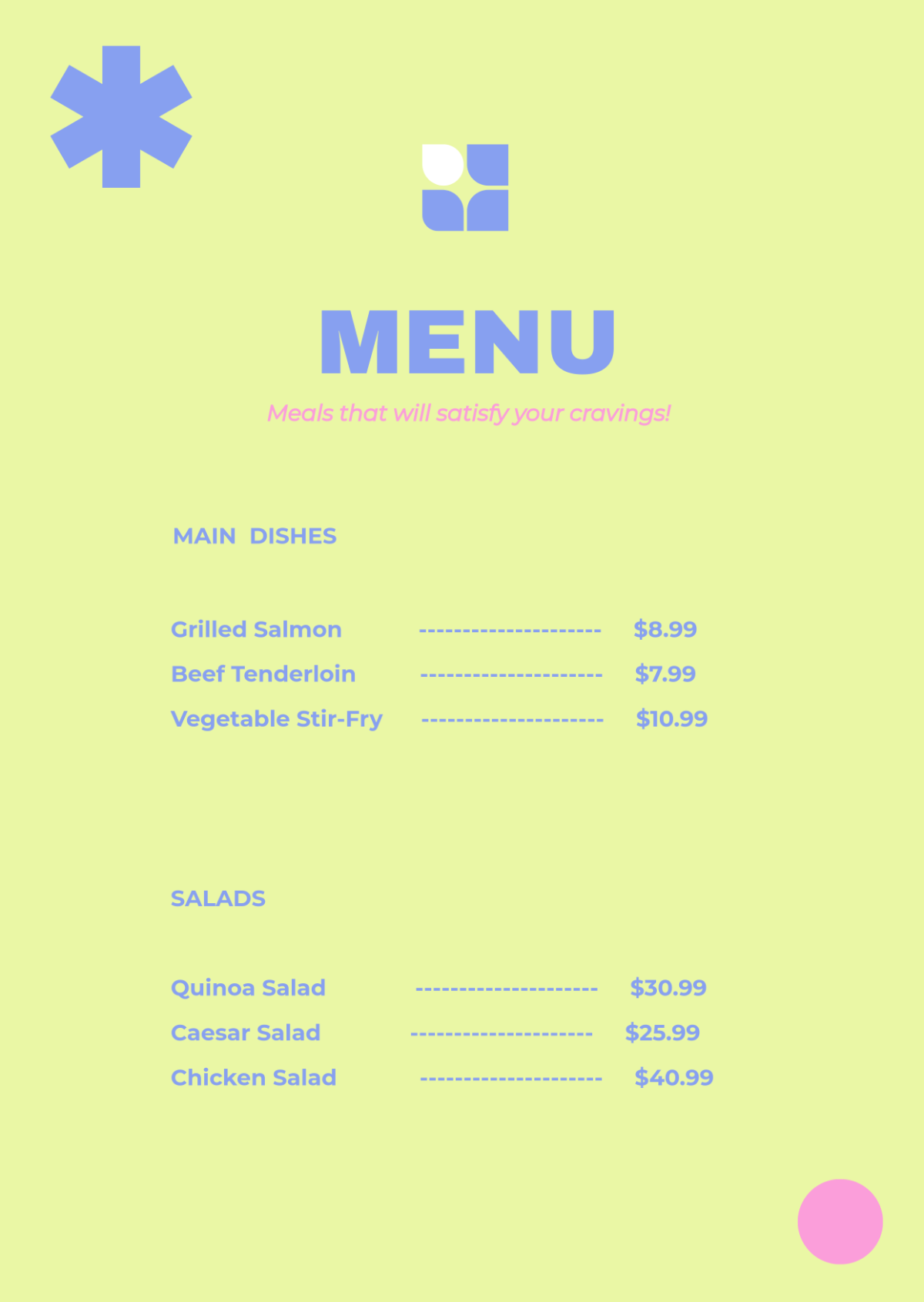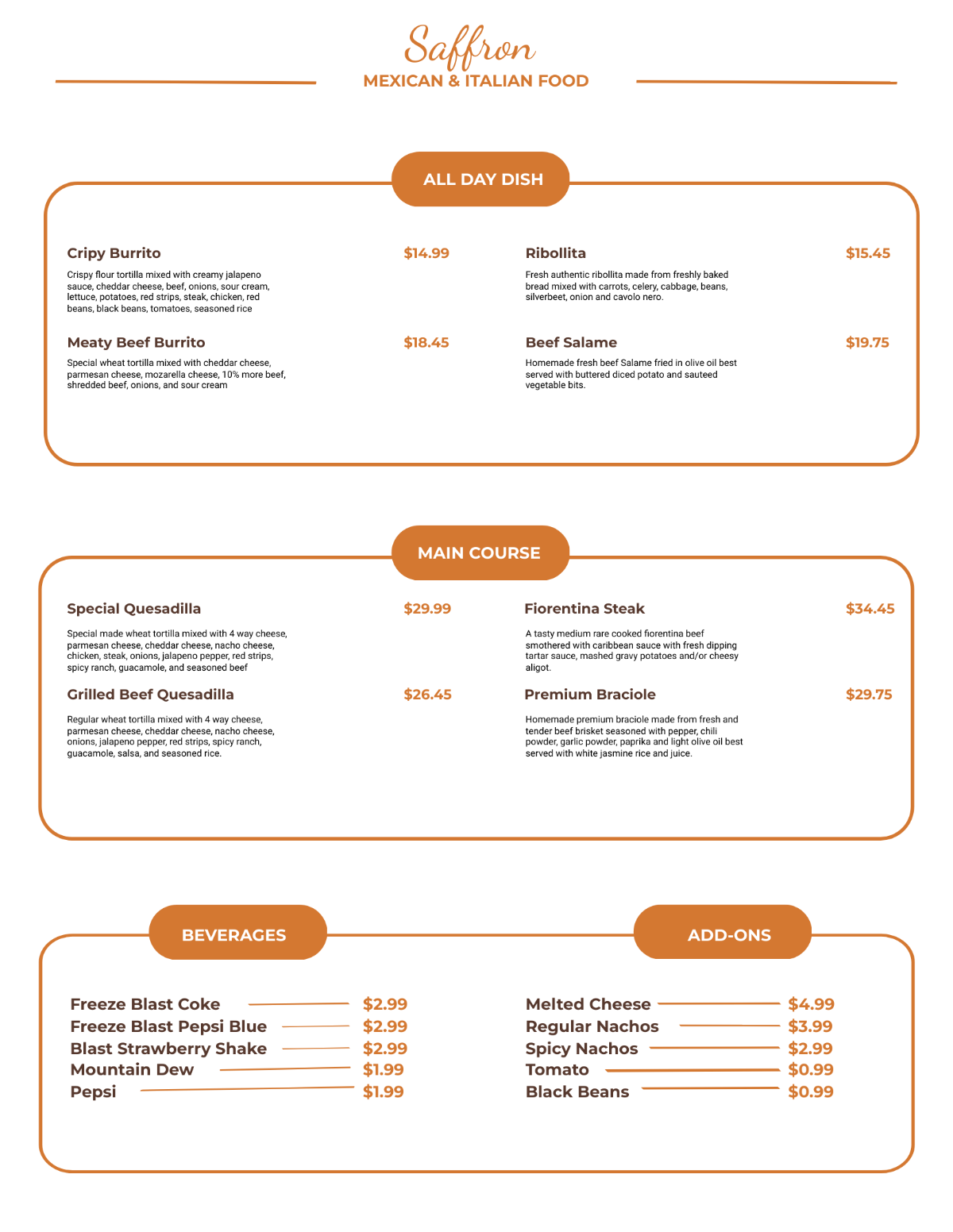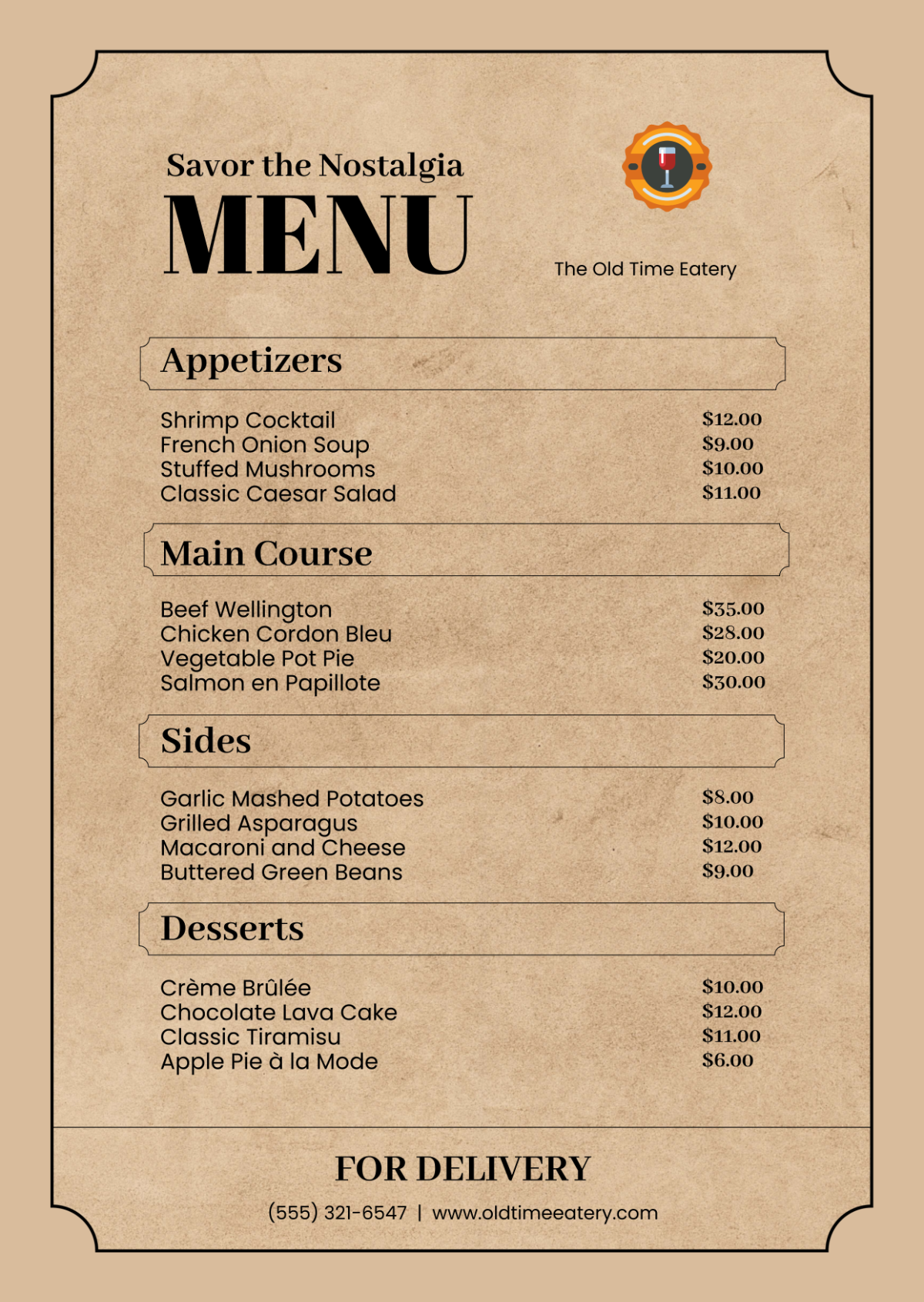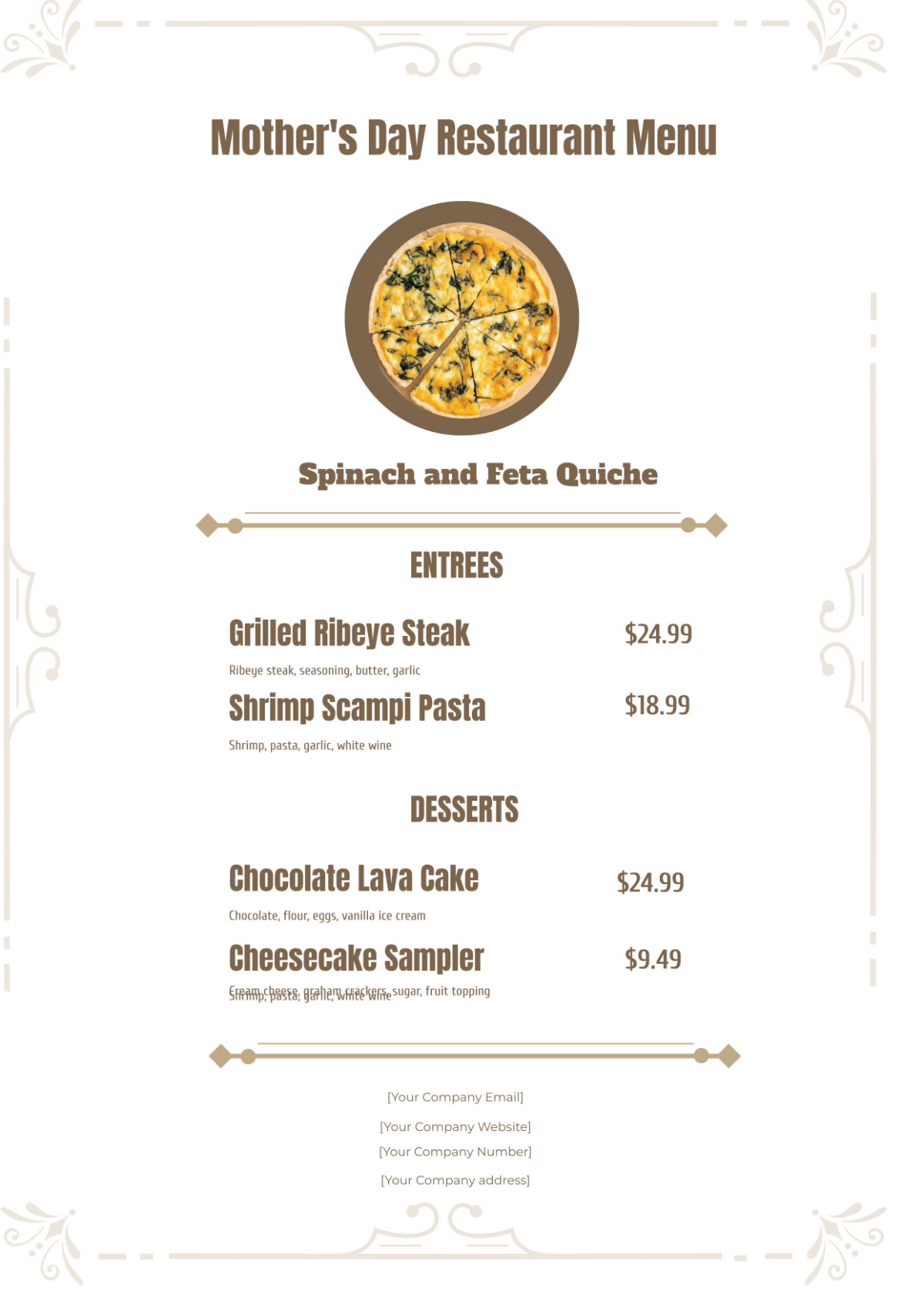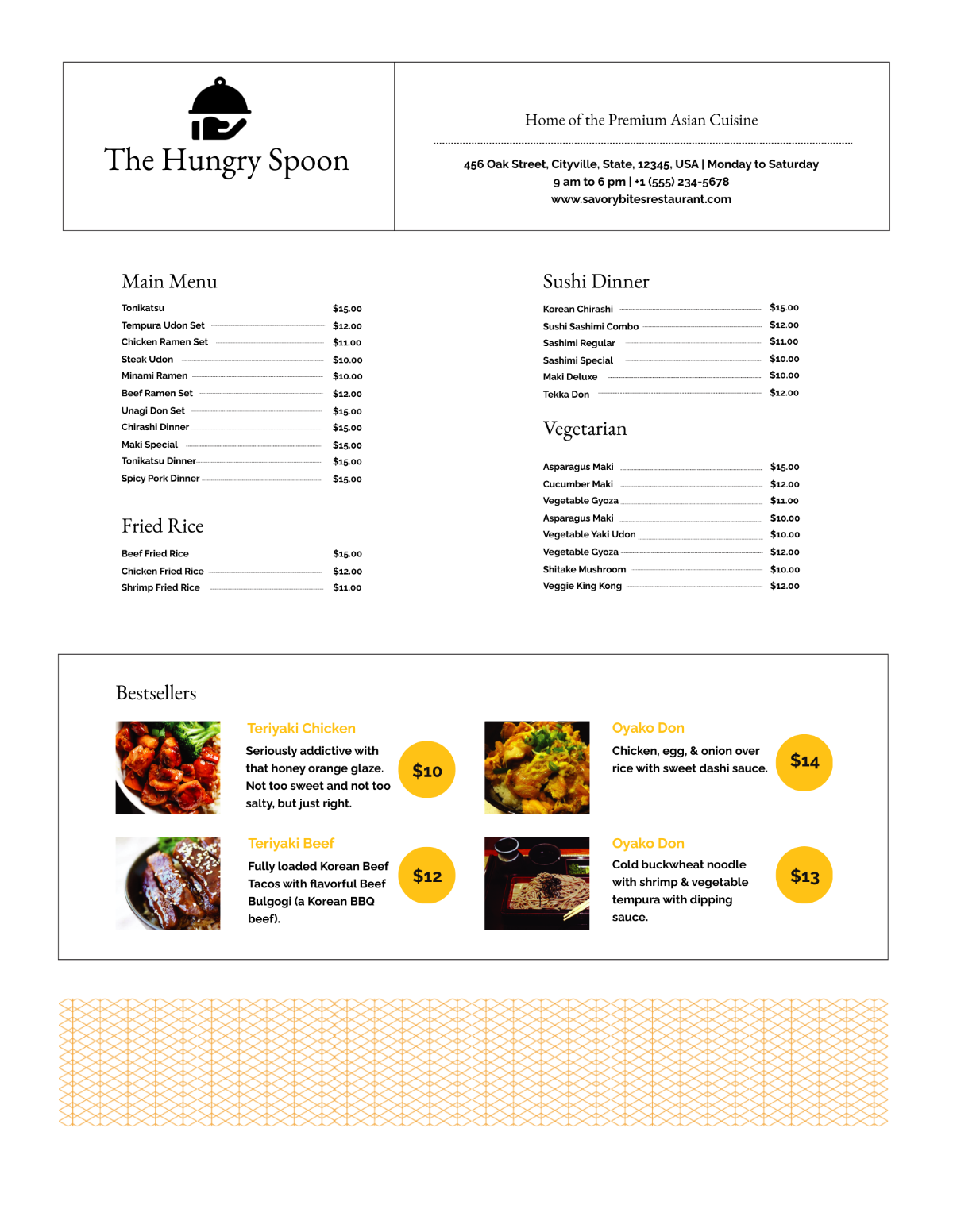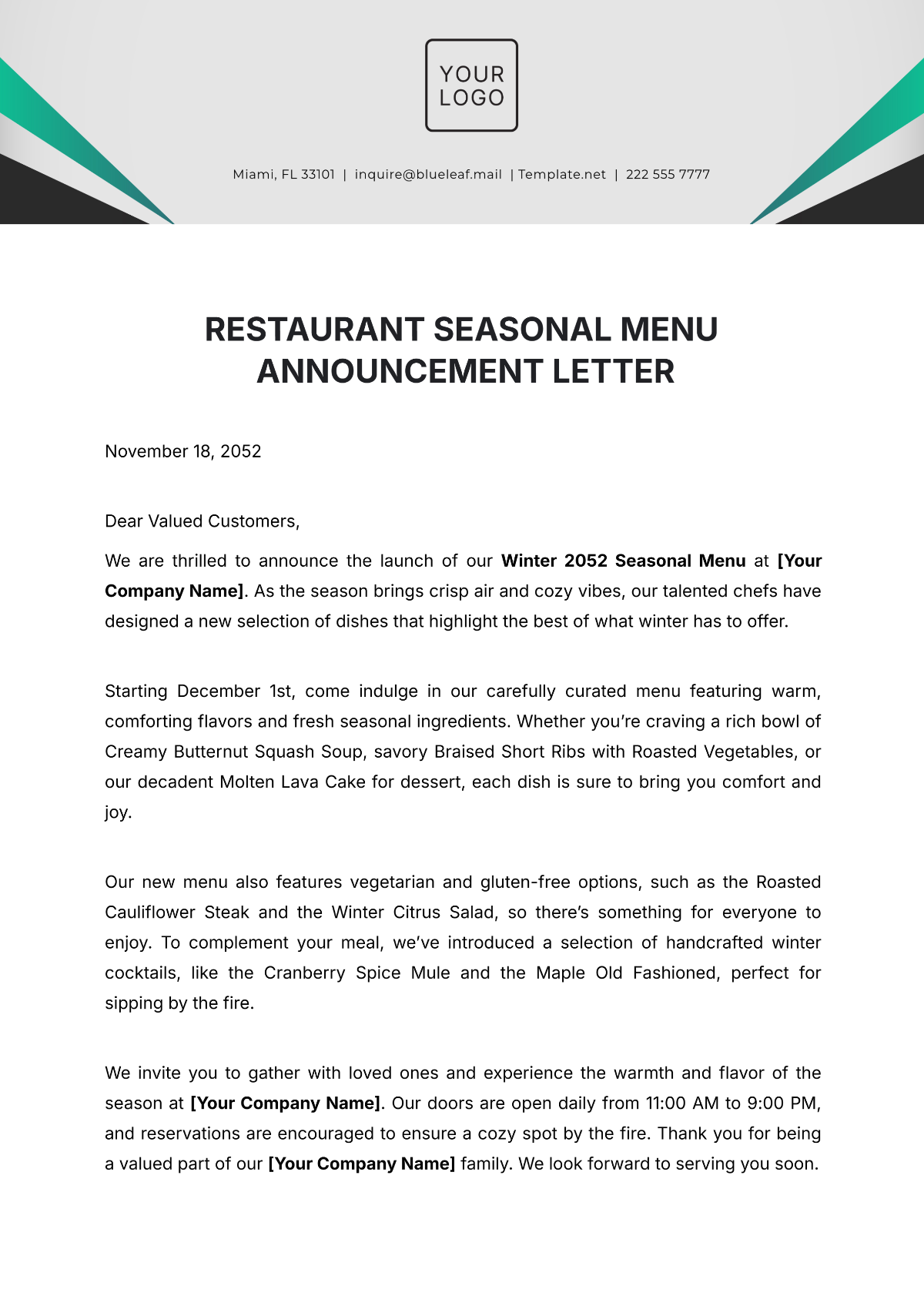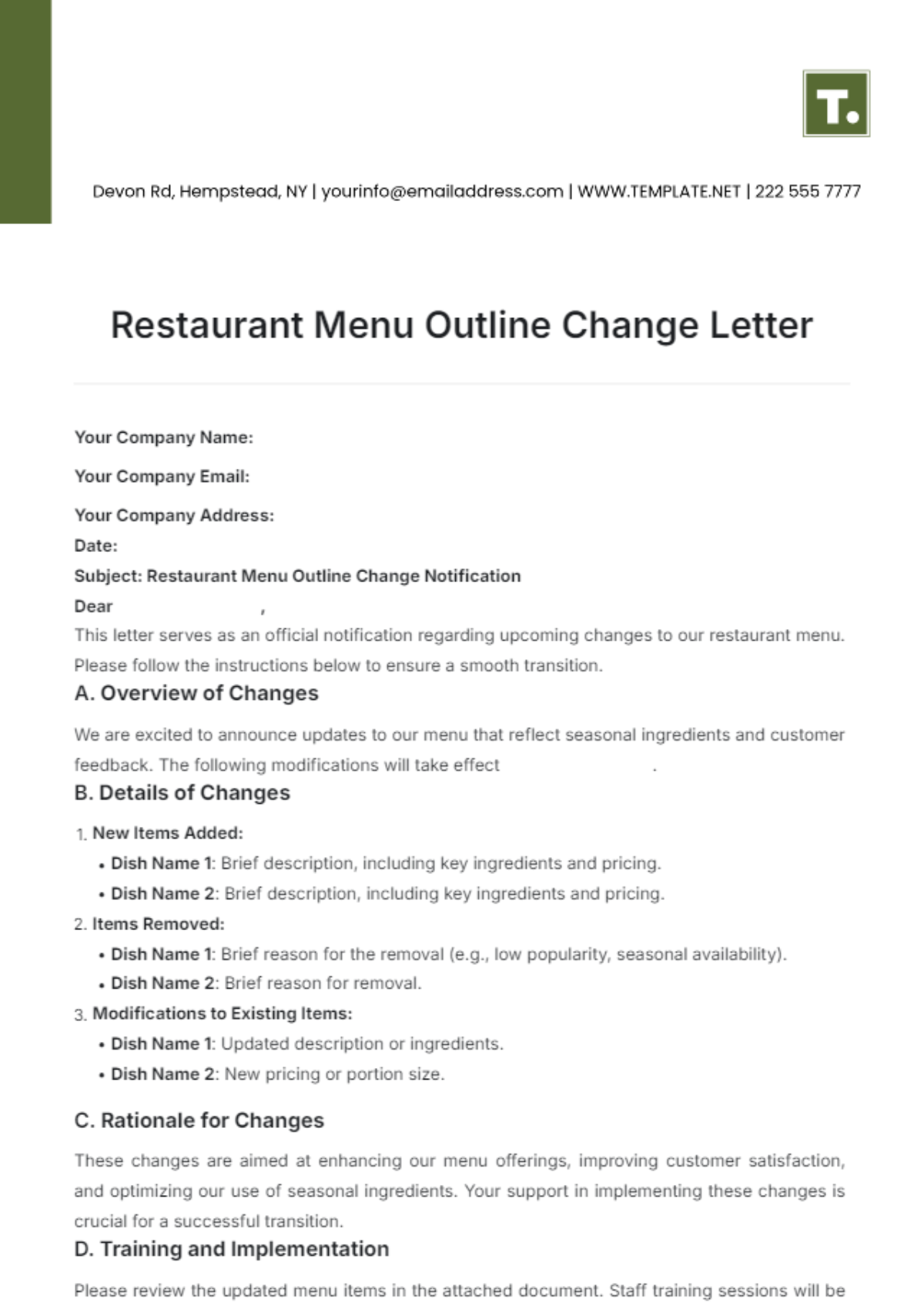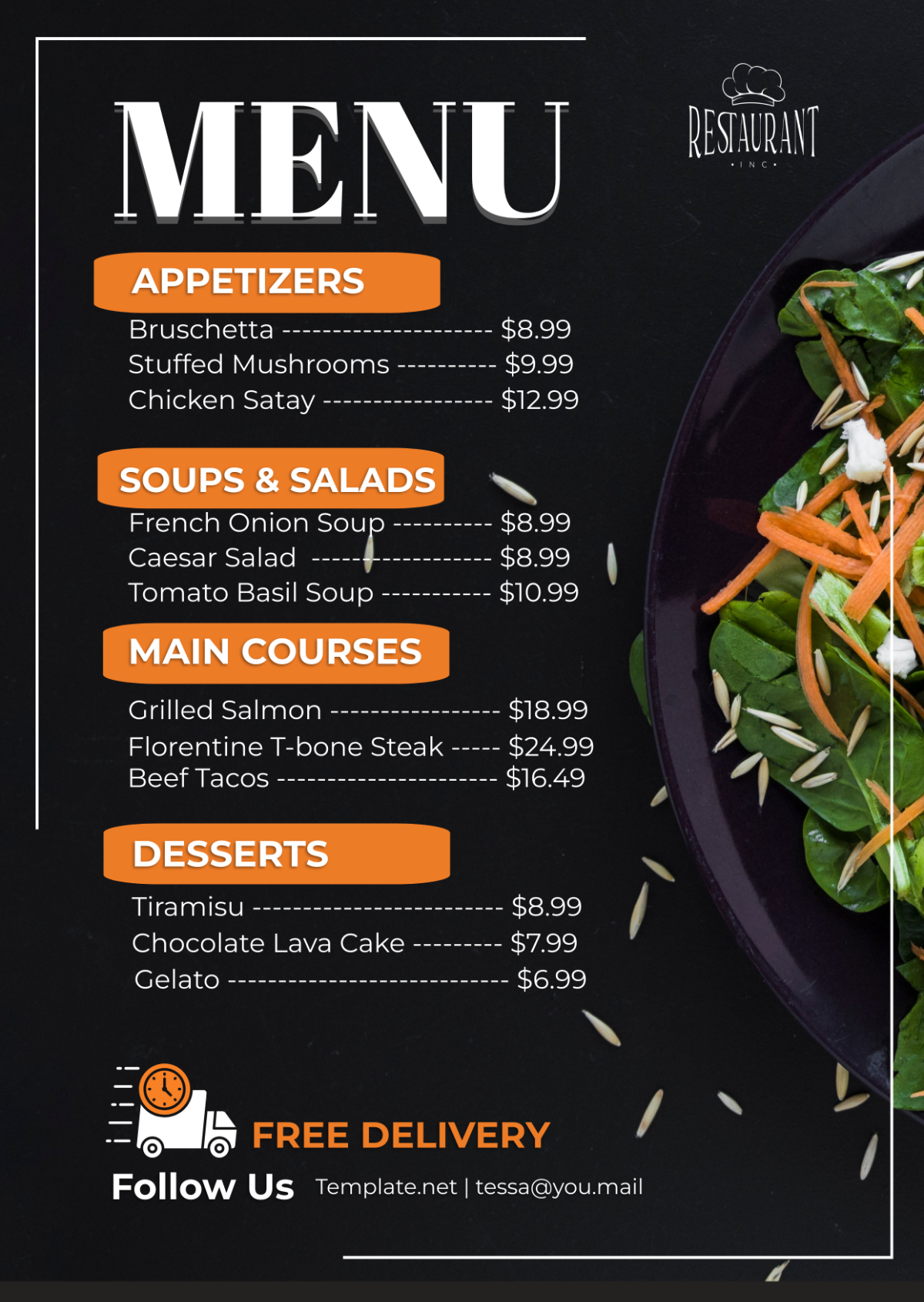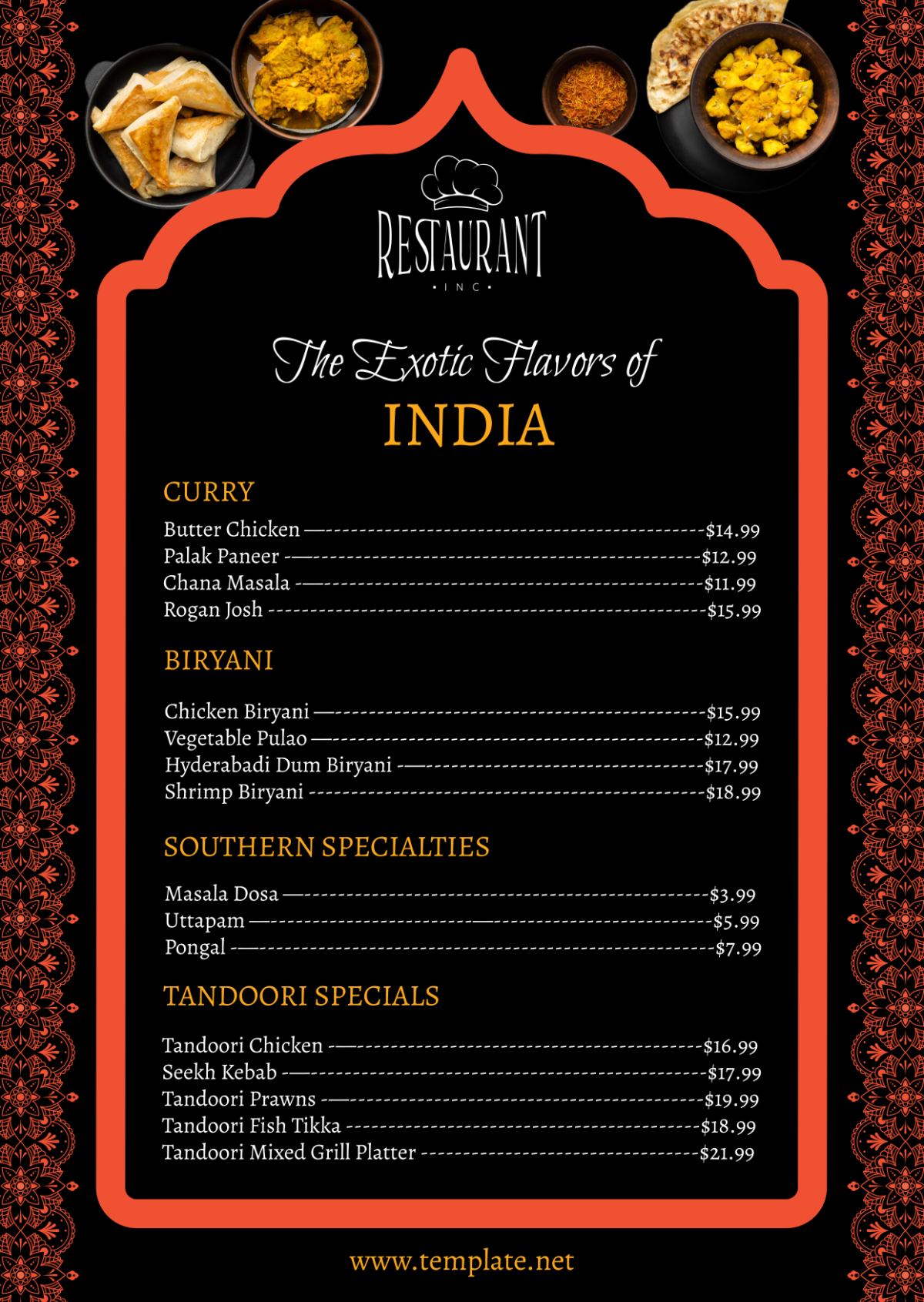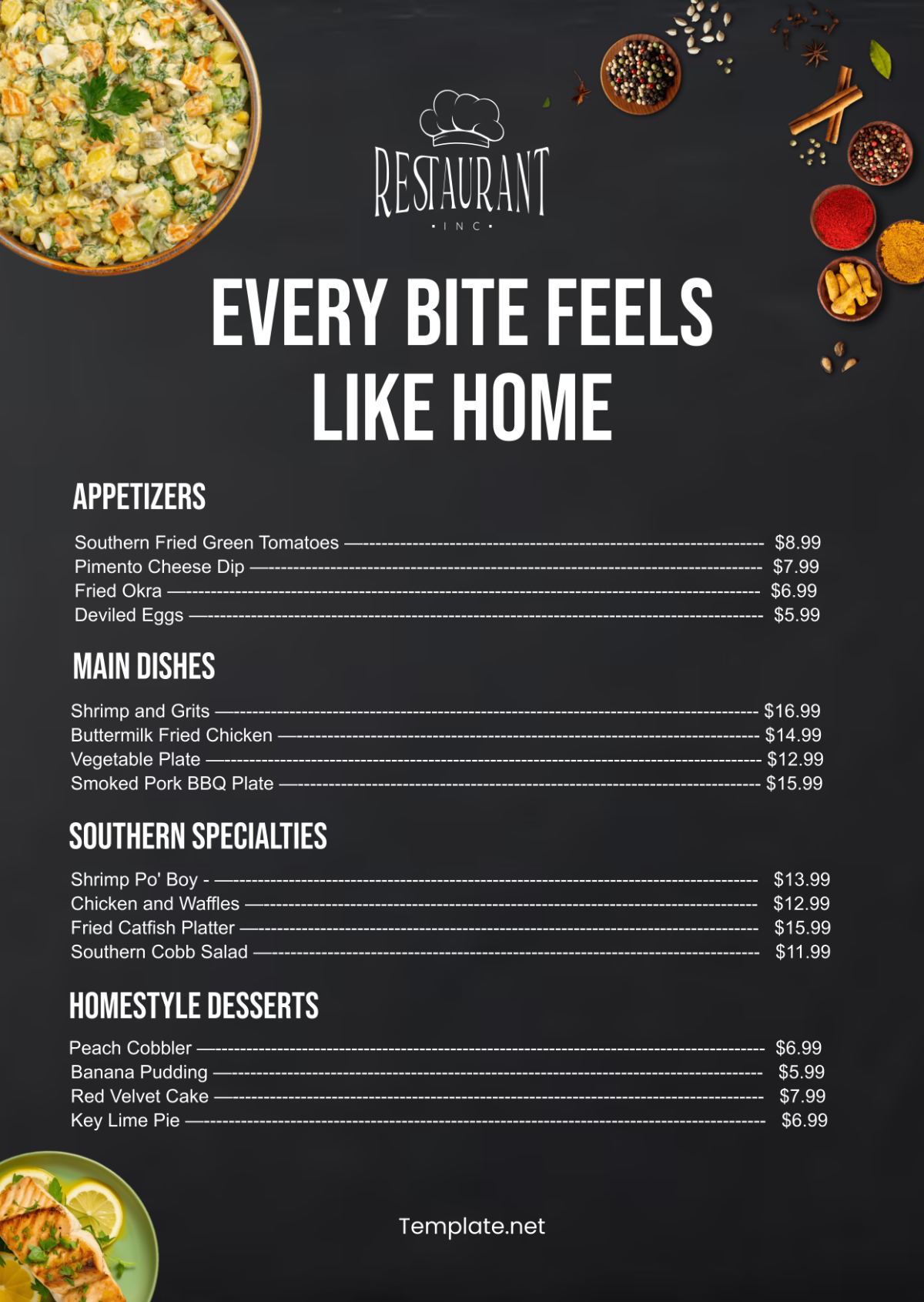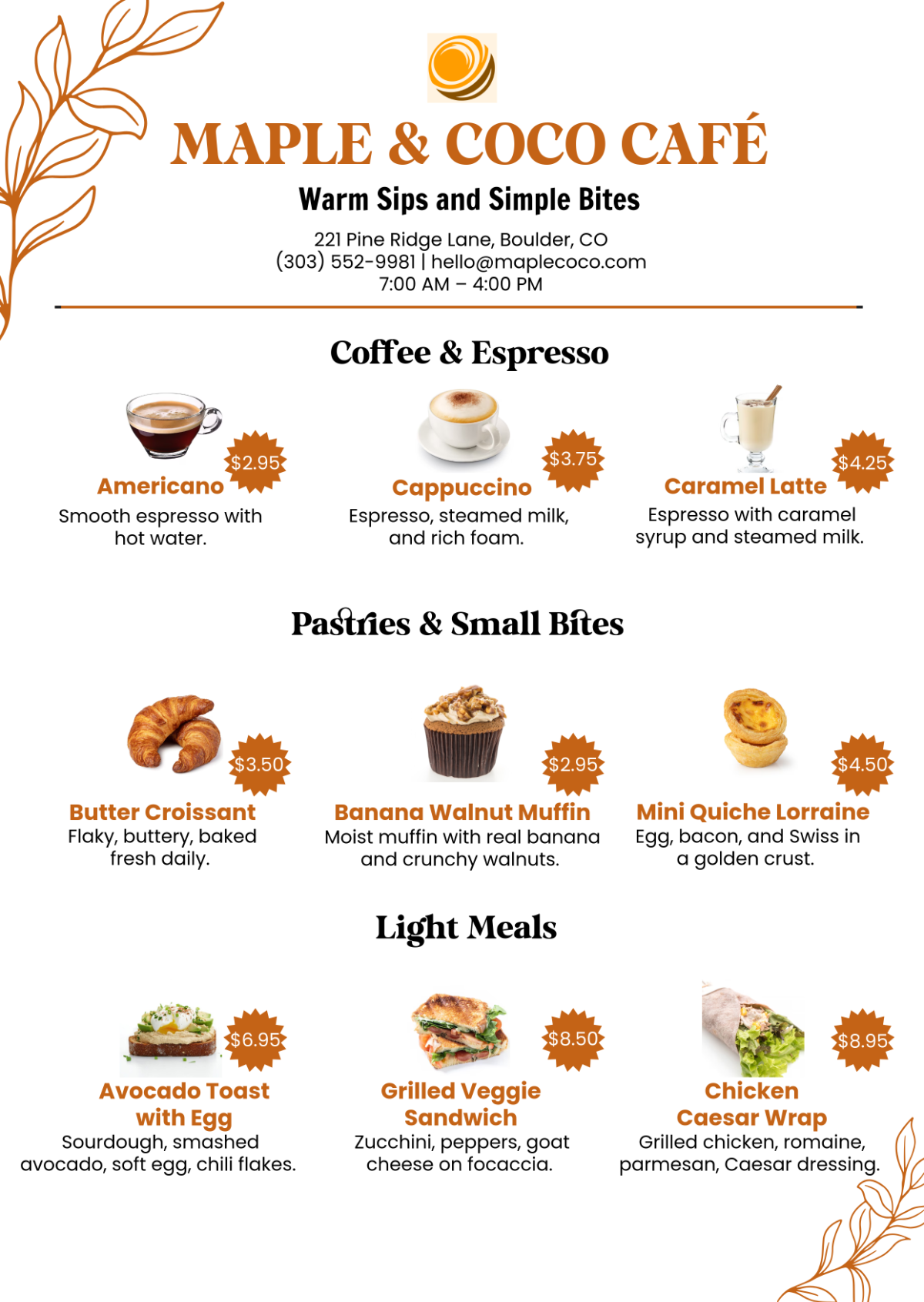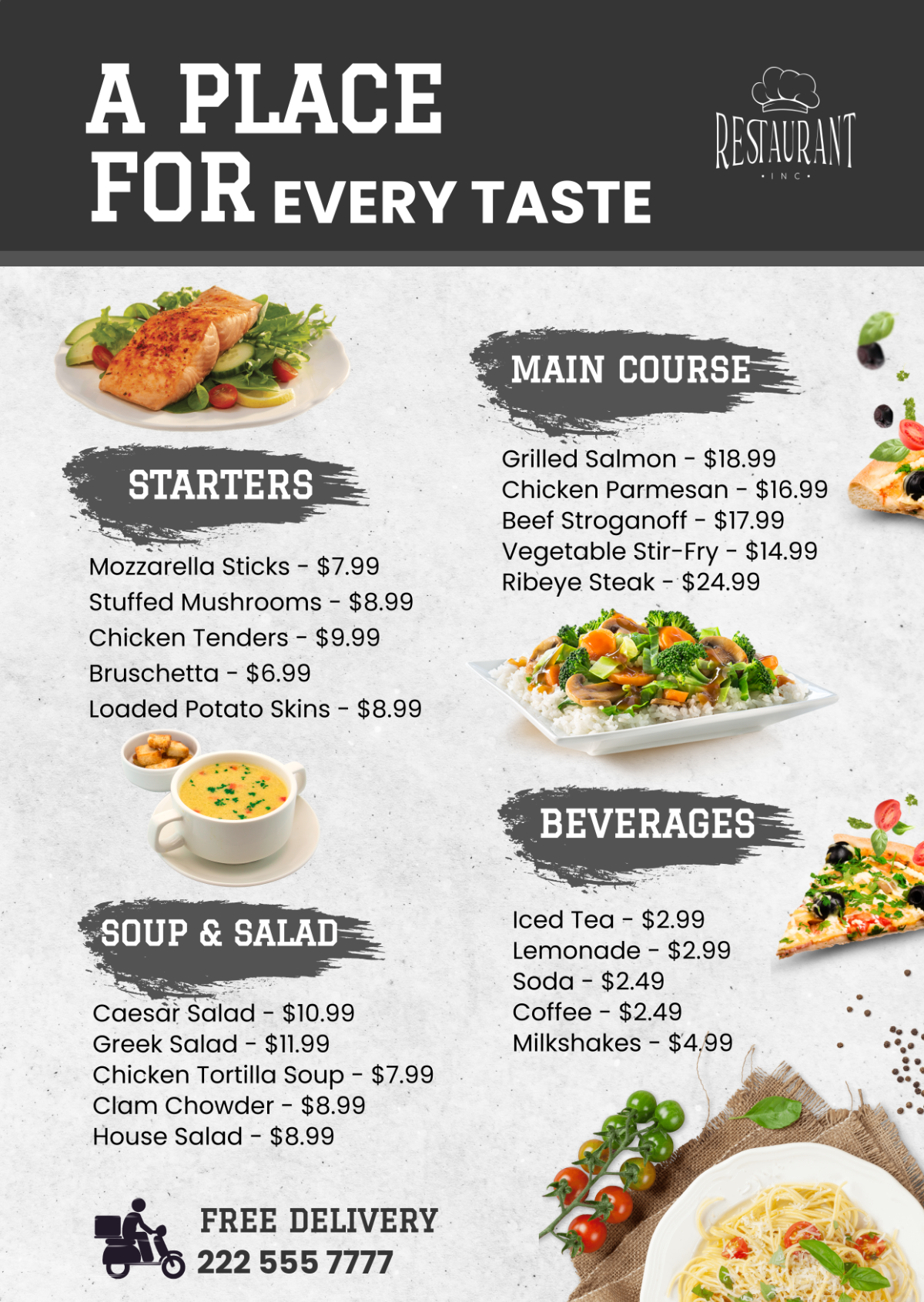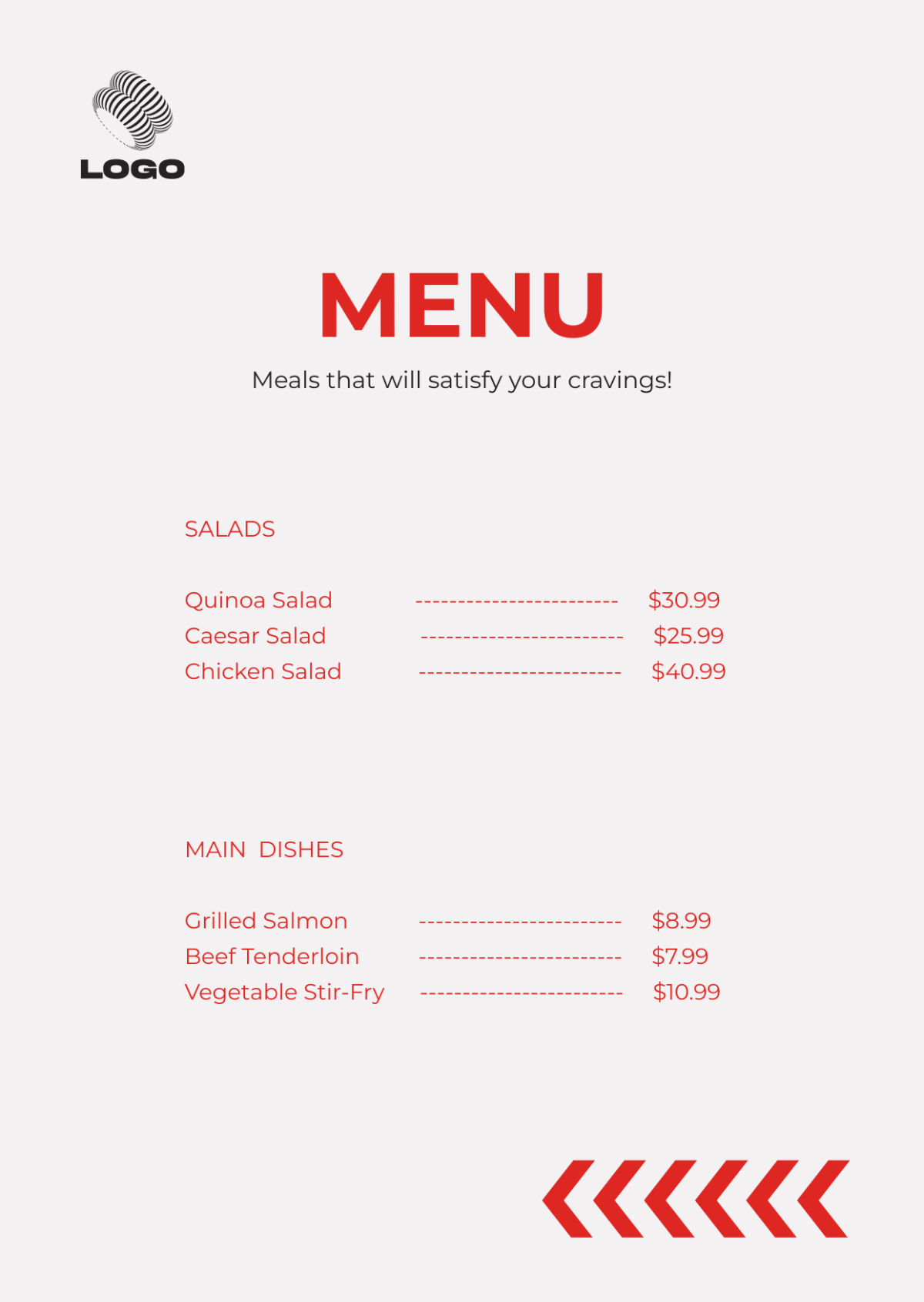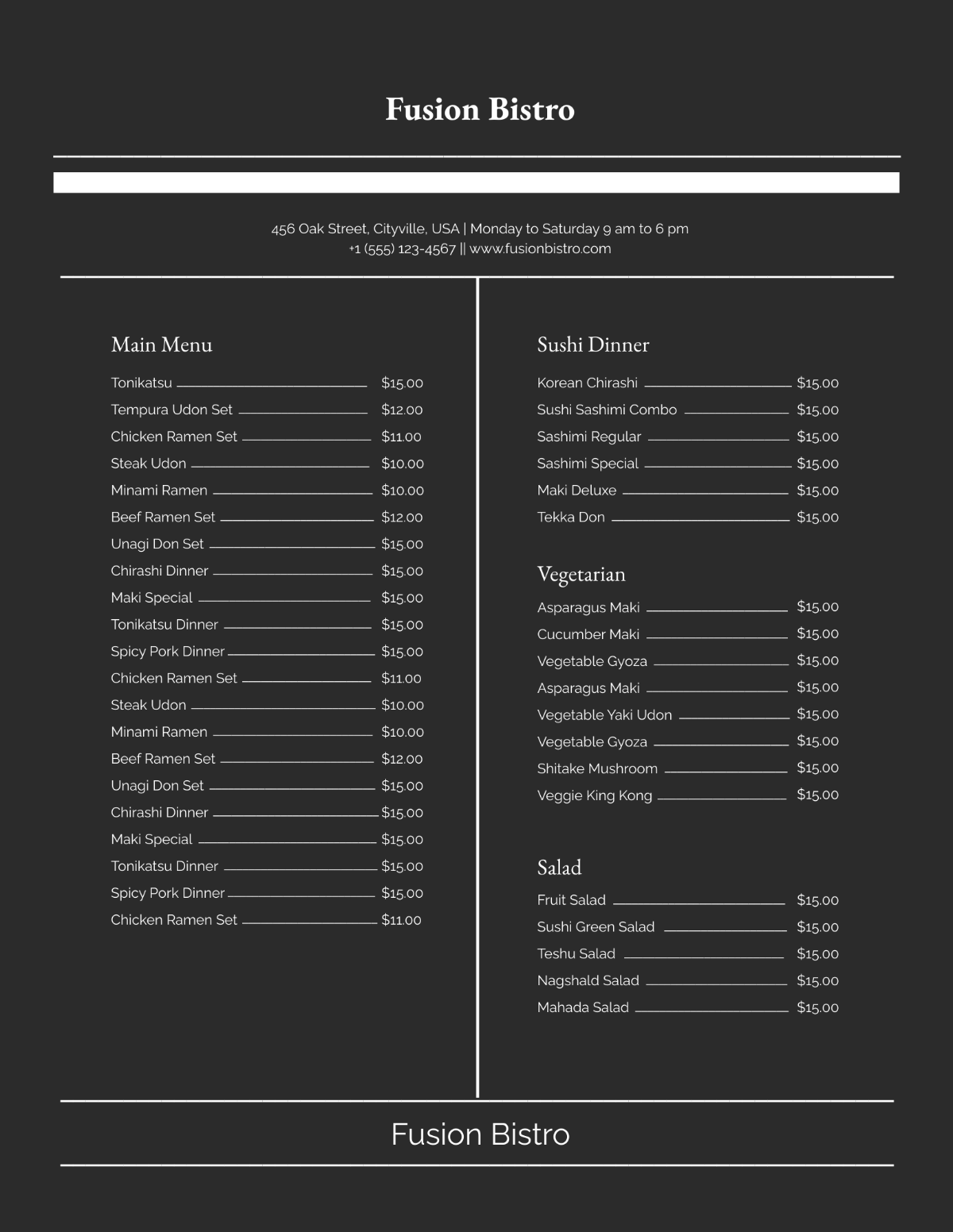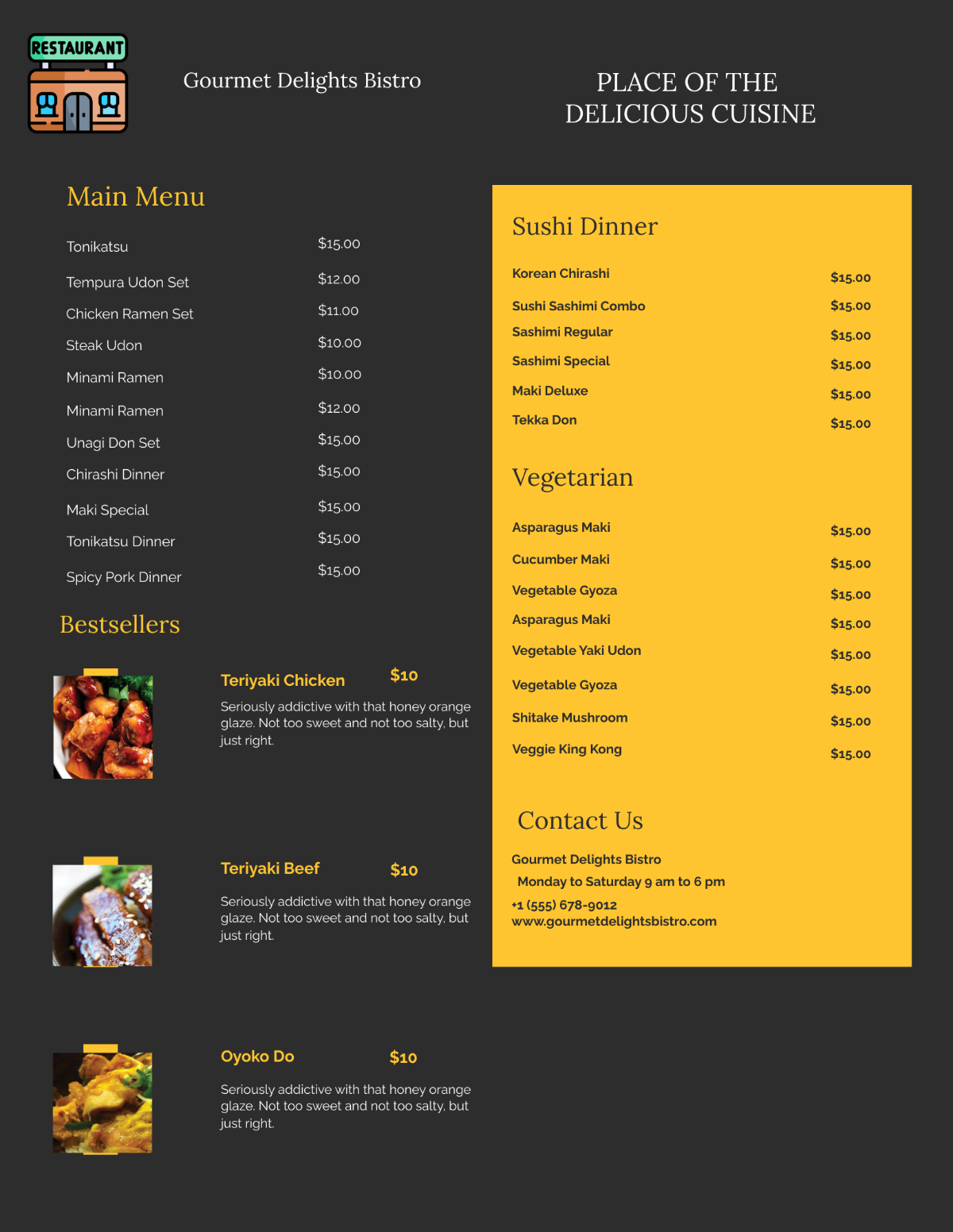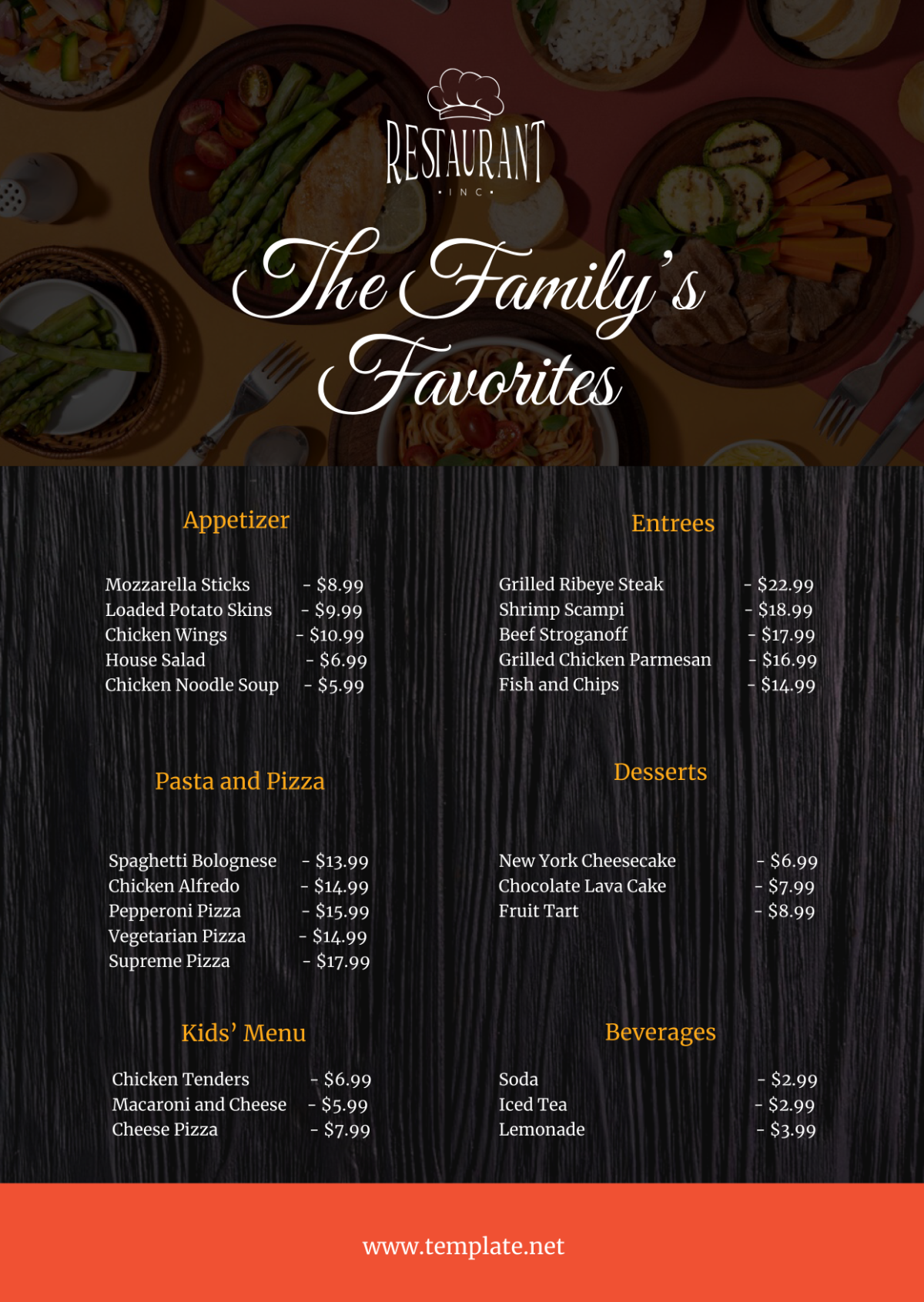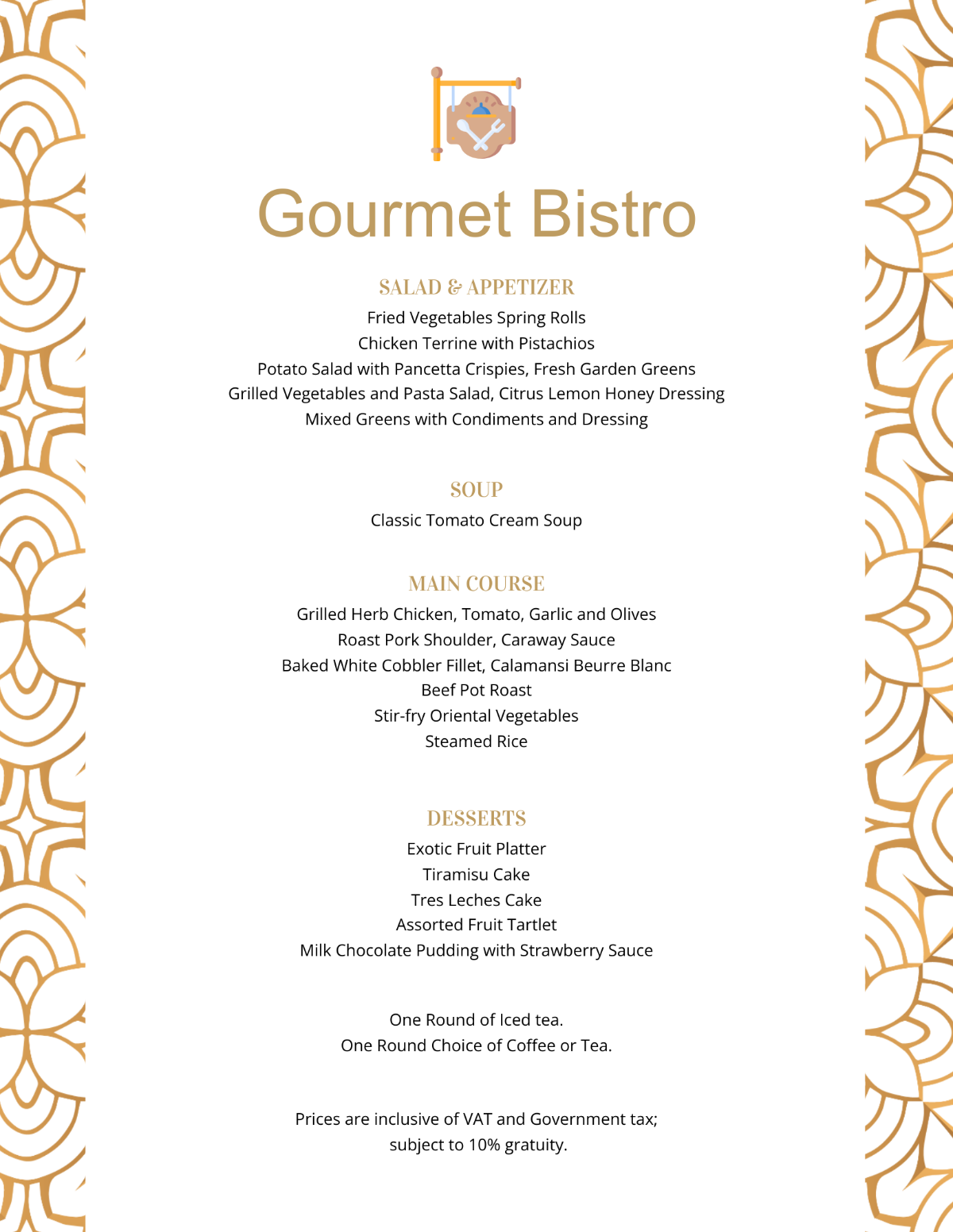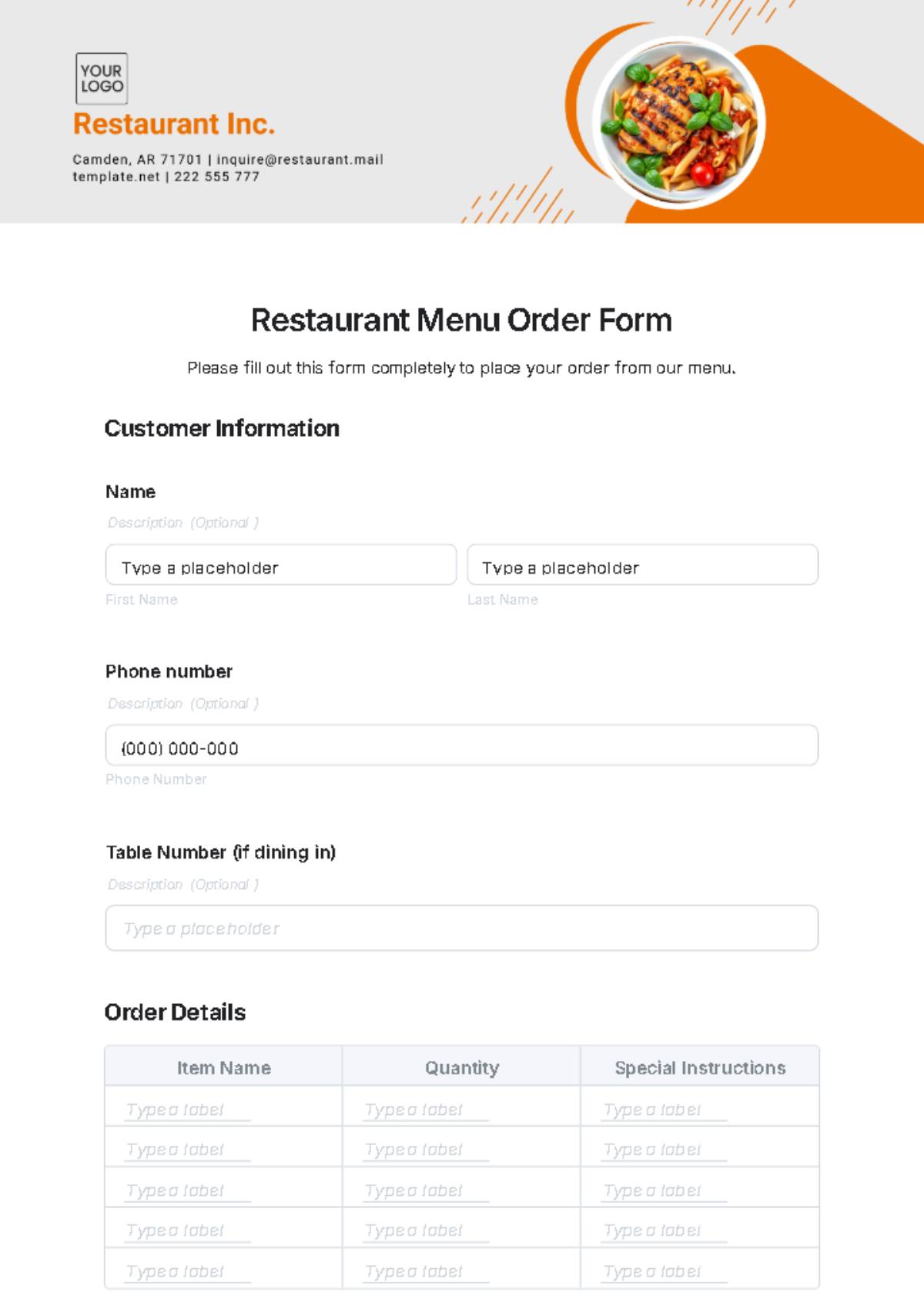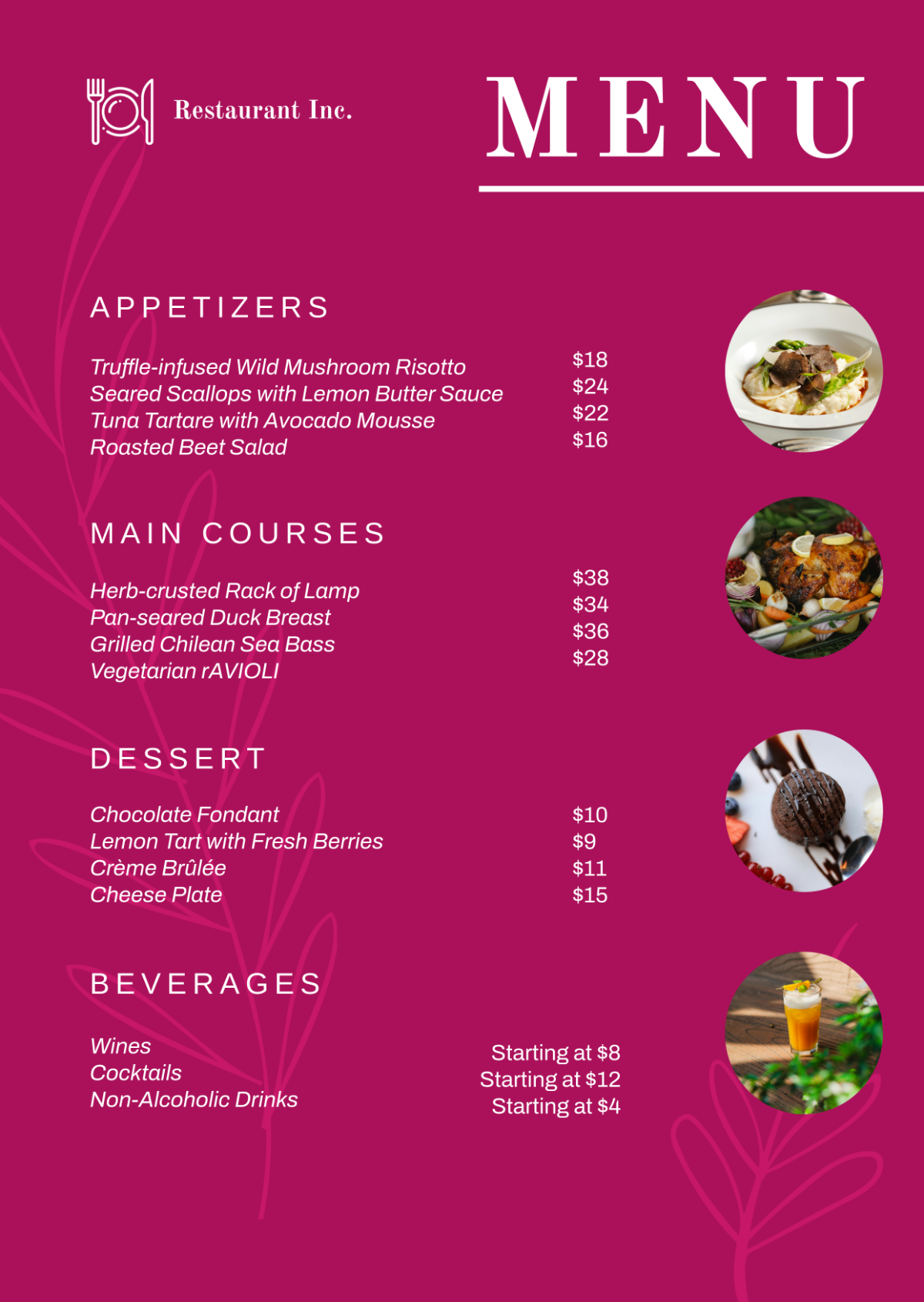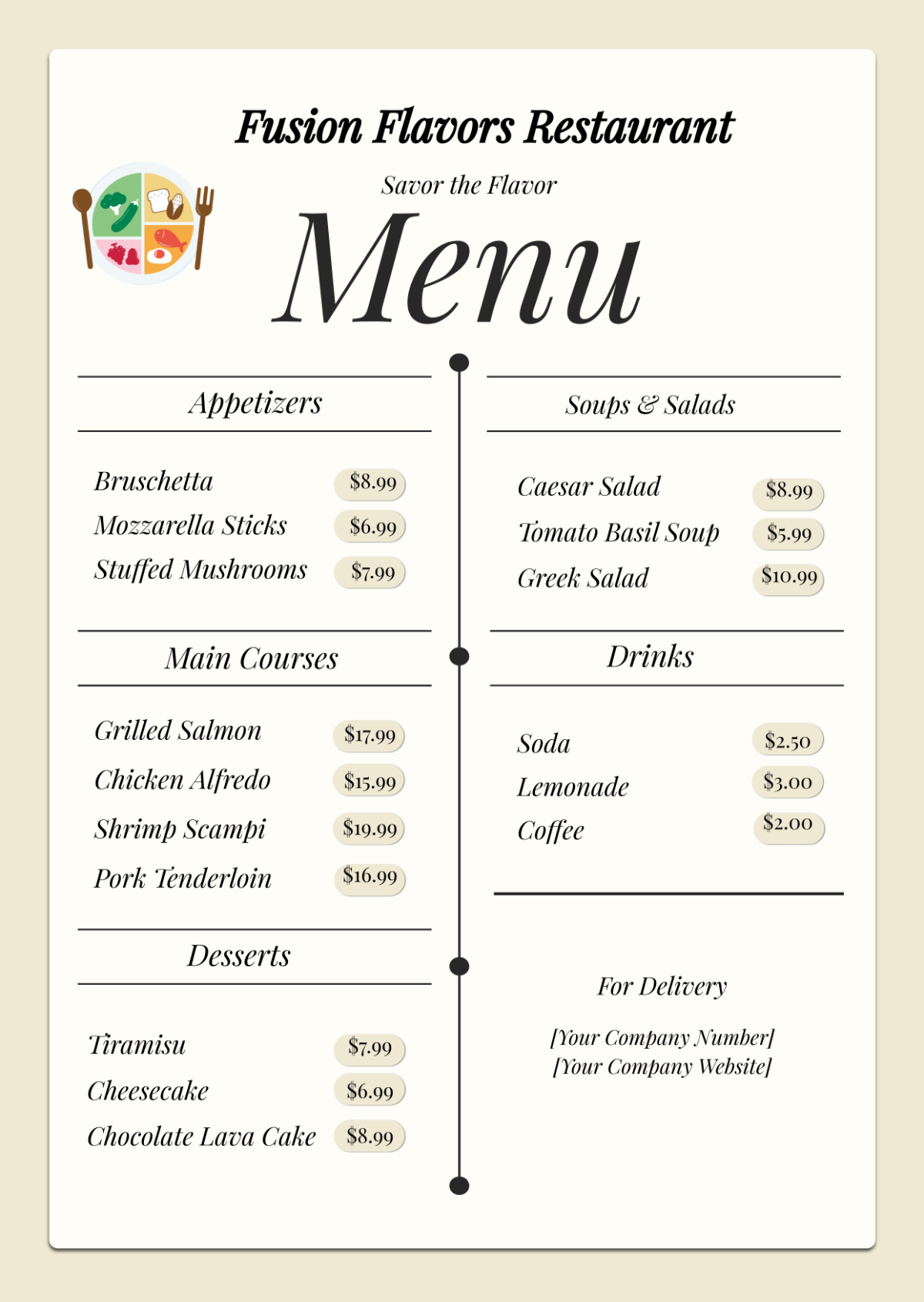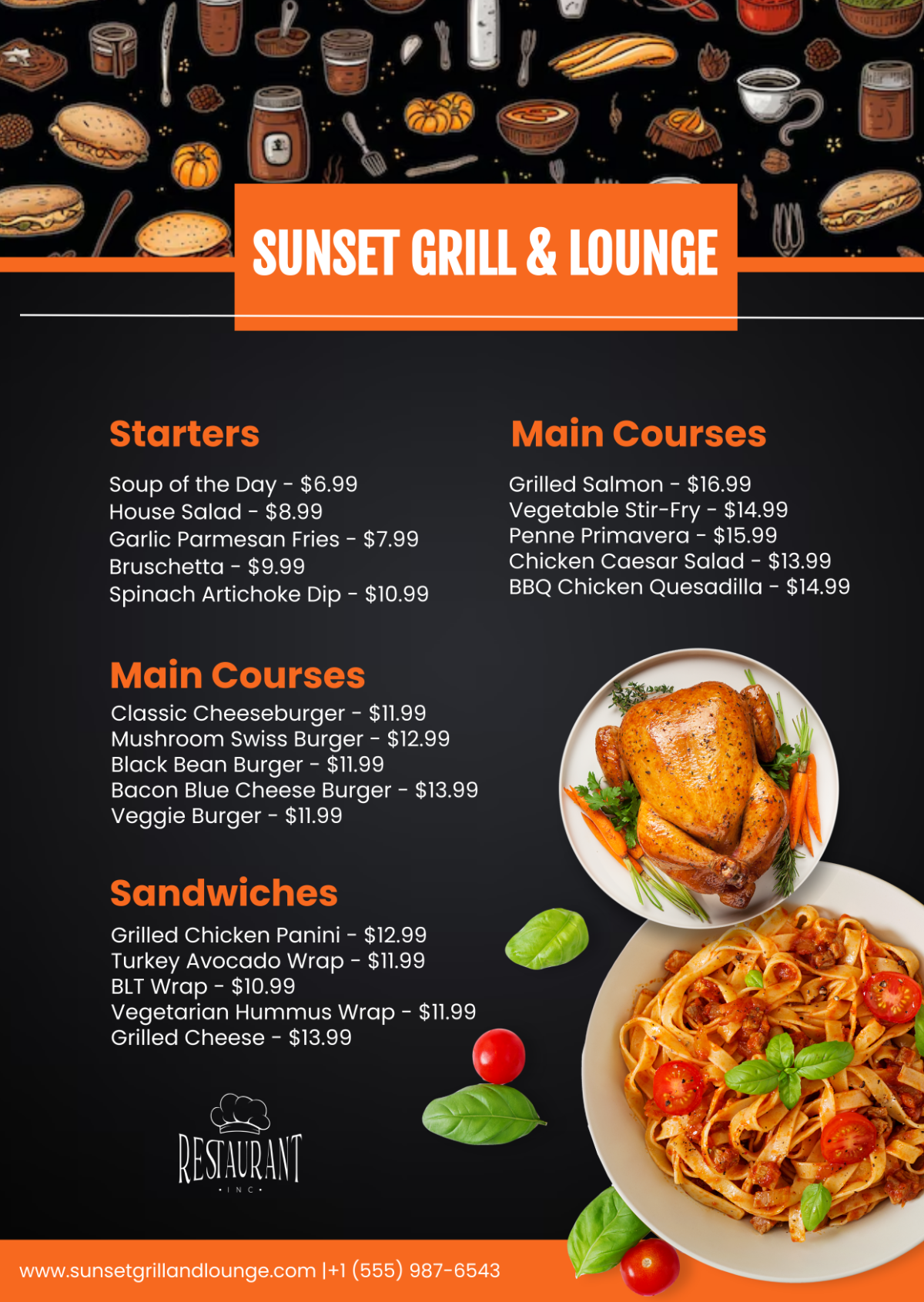I. Introduction
Creating a captivating and clear restaurant menu is a fundamental aspect of a successful dining experience. This Restaurant Menu Design Guide provides essential tips to help you craft a menu that not only appeals visually but also enhances customer satisfaction.
A. Importance of Menu Design
Your menu serves as the face of your restaurant, embodying its identity and setting the tone for the dining experience. Thoughtful menu design not only reflects your establishment's personality but also influences customer decisions and enhances their overall satisfaction. By strategically showcasing special dishes and organizing items in an intuitive layout, you can captivate diners and encourage exploration of your culinary offerings.
Key Points | Details |
|---|---|
Reflects Restaurant Identity | Choose fonts, colors, and imagery that align with your brand aesthetic. For instance, a rustic-themed restaurant may opt for earthy tones and handwritten fonts, while a modern eatery might embrace sleek typography and minimalist design. |
Influences Customer Choices | Utilize design elements such as placement, font size, and imagery to draw attention to high-margin or signature dishes. Strategic positioning of these items can guide customers towards profitable selections while still allowing them to explore the full menu. |
Highlights Special Dishes | Employ visual cues such as icons or borders to distinguish special dishes, promotions, or chef's recommendations. Adding enticing descriptions and vivid imagery can further elevate these offerings, enticing customers to indulge in unique culinary experiences. |
This comprehensive guide ensures that your menu not only captures your restaurant's essence but also maximizes its impact on customer satisfaction and profitability.
B. Who Should Use This Guide
This guide is invaluable for a diverse range of professionals in the restaurant industry, including:
Target Audience | Details |
|---|---|
Restaurant Owners and Managers | Owners and managers seeking to revamp their menu to better reflect their brand identity and optimize profitability will find this guide indispensable. It provides practical strategies for menu design that enhance customer experience and drive revenue growth. |
Graphic Designers Specializing in Menus | Graphic designers specializing in menu design can leverage this guide to gain insights into effective layout principles, typography selection, and visual hierarchy. By mastering these techniques, designers can create visually stunning menus that captivate diners and elevate restaurant branding. |
Marketing Professionals in the Food Industry | Marketing professionals tasked with promoting culinary establishments will benefit from understanding the nuances of menu design. This guide equips them with the knowledge to craft persuasive messaging and visually appealing menus that entice potential customers and drive foot traffic. |
Whether you're a restaurant owner, graphic designer, or marketing professional, this guide empowers you to optimize menu design for maximum impact and success in the competitive food industry landscape.
II. Font and Typography
Selecting the appropriate font is paramount in menu design. The chosen typeface should not only ensure readability but also seamlessly align with the restaurant's theme and ambiance. Whether opting for classic serif fonts for fine dining establishments or modern sans-serif fonts for casual eateries, each decision should reflect the brand's identity and enhance the overall dining experience.
A. Readability
Achieving optimal readability is essential in menu design. Key considerations include selecting a font size that is legible, especially in varying lighting conditions. Additionally, choosing high-contrast color combinations between text and background enhances clarity. Consistency in typography and layout further aids in readability, ensuring that customers can effortlessly navigate the menu and make informed dining choices.
Readability Tips | Details |
|---|---|
Optimal Font Size | Choose a font size that is large enough to be legible, even in dimly lit dining areas. A minimum of 12-point font is recommended for body text, while headings should be larger to stand out and guide customers through the menu effortlessly. |
Contrast and Clarity | Ensure sufficient contrast between text and background colors to enhance readability. Dark text on a light background or vice versa is generally preferred. Additionally, avoid overly decorative fonts that may compromise clarity. |
Consistent Typography | Maintain consistency in typography throughout the menu to establish a cohesive visual identity. Using no more than two to three font styles helps streamline the design while ensuring ease of reading. |
By prioritizing readability, you create a user-friendly menu that enhances the dining experience for your customers, ultimately leading to increased satisfaction and repeat business.
B. Matching the Theme
Harmonizing font choices with your restaurant's theme is pivotal for creating a cohesive ambiance and reinforcing brand identity. Whether it's selecting elegant serif fonts for fine dining venues or playful customized fonts for themed restaurants, each decision should evoke the desired atmosphere and align with the restaurant's unique personality, ensuring a memorable dining experience for patrons.
Theme | Font Recommendation | Examples |
|---|---|---|
Casual Dining | Opt for sans-serif fonts such as Helvetica, Arial, or Open Sans. These clean and modern typefaces are easy to read and convey a relaxed atmosphere, ideal for casual dining establishments. | Sans-serif fonts like Helvetica or Open Sans complement the laid-back ambiance of casual dining restaurants perfectly. |
Fine Dining | Choose elegant serif fonts like Baskerville, Times New Roman, or Garamond to convey sophistication and refinement. These classic typefaces exude timeless elegance and are well-suited for upscale dining experiences. | Serif fonts such as Baskerville or Times New Roman evoke a sense of sophistication, making them ideal for fine dining venues. |
Themed Restaurants | Embrace customized fonts that align with your restaurant's theme and ambiance. Whether whimsical, rustic, or futuristic, tailor the typography to evoke the desired atmosphere and enhance brand cohesion. | Themed restaurants can elevate their branding by using customized fonts that reflect the unique personality and ambiance of the establishment. |
By selecting fonts that harmonize with your restaurant's theme, you create a cohesive visual identity that resonates with customers and enhances their dining experience.
III. Color Scheme
Choosing a color scheme that harmonizes with your restaurant's ambiance is essential for creating a cohesive visual identity. Whether opting for warm, inviting tones for a cozy atmosphere or cool, soothing hues for a contemporary vibe, each color choice should reflect the restaurant's personality and enhance the overall dining experience for guests.
A. Reflect Your Brand
Aligning your menu's color palette with your restaurant's branding reinforces brand identity and sets the tone for the dining experience. Consider the following strategies:
Brand Reflection Tips | Details |
|---|---|
Consistent Color Scheme | Select colors that echo your restaurant's branding to maintain visual coherence and strengthen brand recognition. For example, if your restaurant's logo features blue and green hues, incorporate these colors into your menu design to create a cohesive brand experience across all touchpoints. |
Mood Enhancement through Color | Leverage color psychology to evoke desired emotions and enhance the dining atmosphere. Warm tones like reds, oranges, and yellows can create a cozy and inviting ambiance, perfect for intimate dining settings. Alternatively, cooler tones such as blues and greens can promote a sense of calm and relaxation, ideal for casual or contemporary dining spaces. |
By thoughtfully integrating color into your menu design, you not only reflect your brand identity but also create a visually engaging and mood-enhancing dining experience for your customers.
B. Contrast and Readability
Achieving high contrast between text and background is essential for optimal readability on your menu. Here's how to ensure clarity:
Contrast and Readability Tips | Details |
|---|---|
High Contrast for Legibility | Opt for a text color that stands out prominently against the background to ensure readability, especially in low-light conditions. For instance, black text on a white background or white text on a dark background offers strong contrast and enhances legibility for customers of all ages. |
Minimal Color Palette | Limit the number of colors used on your menu to maintain a clean and uncluttered design. Overuse of colors can overwhelm the reader and distract from the menu items. Instead, employ a restrained color palette that complements your restaurant's branding and enhances visual appeal without sacrificing readability. |
By prioritizing high contrast and a minimalist color palette, you create a menu that is visually appealing and easy for customers to navigate, ensuring a positive dining experience.
IV. Menu Organization
Implementing a logical organization within your menu facilitates effortless navigation for customers, ensuring they can quickly locate their desired dishes. Grouping similar items together and utilizing clear headings and subheadings streamline the browsing experience, enabling patrons to find what they're looking for with ease and enhancing overall satisfaction.
A. Group Similar Items
Organizing menu items into logical categories streamlines the dining experience for your customers. Here's how to effectively group similar items:
Grouping Tips | Details |
|---|---|
Traditional Menu Sections | Arrange menu items into classic categories such as appetizers, mains, desserts, and beverages. This familiar structure makes it easy for customers to navigate the menu and locate their desired dishes efficiently. |
Special Diet Sections | Cater to diverse dietary preferences by including dedicated sections for special diets such as vegetarian, vegan, or gluten-free options. Clearly labeling these sections ensures that customers with specific dietary needs can quickly identify suitable menu choices. |
By thoughtfully grouping similar items, you simplify the menu browsing process for your customers and enhance their overall dining experience.
B. Highlight Signature Dishes
Drawing attention to your restaurant's signature dishes and chef's specials entices customers to explore unique culinary offerings. Here's how to effectively showcase these standout menu items:
Highlighting Strategies | Details |
|---|---|
Use of Icons or Formatting | Employ visual cues such as icons or distinct formatting (e.g., bold text, borders) to highlight signature dishes and chef's specials. This draws attention to these standout items and encourages customers to consider them when making their dining selections. |
Prominent Feature of Chef's Specials | Feature chef's specials prominently on the menu, using eye-catching design elements or placement to ensure they command attention. Providing enticing descriptions and pairing them with appealing imagery further enhances their appeal and encourages customer indulgence. |
By employing strategic highlighting techniques, you effectively showcase your restaurant's most exceptional dishes, enticing customers to explore and savor these culinary delights.
V. Images
Incorporating high-quality images into your menu can captivate customers and stimulate appetite, but it's crucial to exercise restraint. Select images judiciously, ensuring they complement menu items without overwhelming the design. By striking a balance between visual appeal and simplicity, you enhance the menu's effectiveness in enticing diners while maintaining a polished and professional aesthetic.
A. Quality Over Quantity
When incorporating images into your menu, prioritize showcasing your most visually appealing dishes while maintaining a clean and uncluttered layout. Follow these guidelines for optimal presentation:
Quality Focus Tips | Details |
|---|---|
Selective Image Inclusion | Choose high-quality images that accurately represent your restaurant's cuisine and showcase your best-looking dishes. Including only the most visually appealing photographs enhances the overall aesthetic of the menu and entices customers to explore your offerings further. |
Avoid Menu Overcrowding | Resist the temptation to overcrowd the menu with too many images, as this can overwhelm customers and detract from the readability of the text. Opt for a balanced approach, incorporating images sparingly to complement the menu items without overshadowing them. |
By prioritizing quality over quantity in your menu's visual elements, you create a visually engaging presentation that highlights your restaurant's culinary prowess and entices customers to dine with you.
B. Placement of Images
Strategic placement of images alongside relevant menu items enhances visual appeal and aids in decision-making for customers. Follow these guidelines for effective image placement:
Image Placement Strategies | Details |
|---|---|
Adjacent to Relevant Menu Items | Position images adjacent to corresponding menu items to provide visual cues and aid in the selection process. Placing images strategically next to descriptions helps customers envision the dishes and increases their appetite for the showcased offerings. |
White Space for Clean Layout | Ensure there is ample white space around images to maintain a clean and uncluttered layout. Sufficient white space allows the images to stand out and prevents visual overload, contributing to a visually appealing menu design that enhances readability and customer experience. |
By strategically placing images next to relevant menu items and incorporating adequate white space, you create a visually appealing menu layout that effectively showcases your culinary creations and facilitates customer decision-making.
VI. Descriptions
Crafting concise yet engaging descriptions is key to enticing customers and guiding their dining choices. Highlighting unique ingredients and flavors in a succinct manner captivates interest while ensuring clarity. By striking a balance between brevity and comprehensiveness, you enhance the menu's effectiveness in piquing curiosity and enhancing the overall dining experience.
A. Engaging Descriptions
Crafting captivating descriptions for menu items enhances customer interest and encourages exploration of your culinary offerings. Follow these guidelines to create engaging and enticing menu descriptions:
Description Strategies | Details |
|---|---|
Taste, Texture, and Special Ingredients | Provide vivid descriptions that evoke the taste and texture of each dish, highlighting special ingredients and flavor profiles. For example, describe a dish as "succulent grilled chicken breast, glazed with tangy barbecue sauce and served with a side of crispy sweet potato fries." Incorporating sensory language engages customers and piques their curiosity. |
Origins for Exotic Appeal | Add intrigue to your menu by including the origins or cultural inspirations behind certain dishes. For instance, describe a dish as "spicy Thai curry made with fresh lemongrass, coconut milk, and vibrant vegetables, offering a taste of the bustling streets of Bangkok." Sharing the backstory adds depth and authenticity, enhancing the dining experience. |
By incorporating engaging descriptions that detail taste, texture, special ingredients, and origins, you create an immersive culinary journey for your customers, enticing them to explore and savor the diverse flavors of your menu.
B. Length of Descriptions
Maintaining concise descriptions ensures that menu items are easily scannable and digestible for customers. Follow these guidelines to keep descriptions succinct and impactful:
Length Guidelines | Details |
|---|---|
Concise Descriptions | Craft descriptions that are brief and to the point, ideally around 1-2 sentences in length. Focus on conveying essential information such as key ingredients, flavors, and unique features. For example, "Tender filet mignon, grilled to perfection and served with a rich mushroom demi-glace." |
By adhering to concise description lengths, you streamline the menu browsing experience for customers, allowing them to quickly assess menu options and make informed dining decisions.
VII. Menu Layout
An aesthetically pleasing and easy-to-navigate layout is paramount in enhancing the dining experience for customers. Striking the right balance between visual appeal and functionality ensures that patrons can effortlessly explore the menu, leading to increased satisfaction and a positive perception of your restaurant.
A. Ease of Navigation
Facilitating effortless navigation through your menu enhances the dining experience for customers. Follow these guidelines for intuitive menu organization:
Navigation Strategies | Details |
|---|---|
Logical Flow of Sections | Arrange menu sections in a logical sequence, guiding customers through a seamless culinary journey from starters to desserts. This intuitive progression helps customers navigate the menu effortlessly and plan their dining experience accordingly. |
Clear Headings and Subheadings | Use clear and descriptive headings and subheadings to delineate different sections of the menu. For example, "Appetizers," "Mains," "Desserts," and "Beverages" provide clear signposts that aid customers in locating specific menu categories with ease. |
By prioritizing logical flow and employing clear headings and subheadings, you create a user-friendly menu that enhances customer satisfaction and facilitates smooth navigation through your culinary offerings.
B. Aesthetic Appeal
Achieving aesthetic harmony in your menu design enhances its visual appeal and elevates the dining experience for customers. Follow these guidelines for a visually captivating menu layout:
Aesthetic Strategies | Details |
|---|---|
Balanced Text and Images | Strike a balance between text and images to create a visually engaging layout. Incorporate images sparingly and ensure they complement, rather than overwhelm, the text. This balanced approach enhances the overall aesthetic appeal of the menu while showcasing your culinary offerings effectively. |
Consistent Spacing and Alignment | Maintain consistent spacing and alignment throughout the menu to create a cohesive visual presentation. Evenly spaced text and aligned elements contribute to a polished and professional look, enhancing readability and aesthetic appeal. Consistency in design elements fosters a sense of coherence and attention to detail. |
By integrating balanced text and images while maintaining consistent spacing and alignment, you create a visually appealing menu that captivates customers and reflects the quality of your culinary offerings.
VIII. Seasonal and Trend Updates
Regularly refreshing your menu to incorporate seasonal ingredients and reflect current food trends ensures its relevance and appeal to diners. By staying attuned to seasonal availability and evolving culinary preferences, you demonstrate a commitment to quality and innovation, enticing customers with fresh and exciting dining options.
A. Seasonal Changes
Incorporating seasonal dishes into your menu showcases the freshest ingredients and ensures culinary variety throughout the year. Follow these guidelines for effective management of seasonal changes:
Seasonal Adaptation Strategies | Details |
|---|---|
Highlight Fresh Ingredients | Feature seasonal dishes that highlight the availability of fresh, locally sourced ingredients. For example, in the spring, offer a vibrant salad with crisp greens, strawberries, and goat cheese, showcasing the flavors of the season. |
Adjustments for Ingredient Availability | Make menu adjustments based on ingredient availability to ensure freshness and quality. For instance, during the winter months, replace summer fruits with hearty root vegetables in salads or switch to warming soups and stews featuring seasonal produce. |
By incorporating seasonal dishes and making adjustments based on ingredient availability, you provide customers with a dynamic dining experience that celebrates the flavors of each season while maintaining culinary excellence.
B. Trend Adaptation
Staying abreast of food trends and adapting your menu accordingly attracts trend-conscious customers and keeps your offerings fresh and exciting. Follow these strategies for effective trend adaptation:
Trend Adaptation Strategies | Details |
|---|---|
Incorporate Popular Food Trends | Integrate popular food trends into your menu to appeal to trend-conscious customers. For example, offer plant-based options to cater to the growing demand for vegetarian and vegan dishes or feature global flavors inspired by street food trends from around the world. |
Experiment with New Dishes | Keep your menu dynamic and exciting by experimenting with new dishes and flavors. Introduce seasonal specials or chef's creations that showcase innovative techniques and ingredients, providing customers with novel dining experiences and enticing them to return for more. |
By incorporating popular food trends and experimenting with new dishes, you keep your menu fresh and appealing to a diverse range of customers, ensuring continued patronage and culinary excitement.
IX. Conclusion
By following this Restaurant Menu Design Guide, you can create a menu that not only reflects your restaurant’s unique identity but also enhances the dining experience. A well-designed menu serves as a powerful marketing tool, showcasing your culinary offerings in a way that entices and delights customers. Ensure that every element, from font choice to color scheme, aligns with your brand and communicates the essence of your restaurant.
Remember to keep the design simple yet effective. Avoid clutter and ensure that the layout is easy to navigate with logical sections and clear headings. Engaging descriptions that highlight the taste, texture, and unique ingredients of each dish can entice diners and provide a deeper connection to your culinary creations. Emphasize high-quality images of your best-looking dishes to visually stimulate appetite while maintaining a clean and balanced design.
Finally, ensure the overall layout is aesthetically pleasing with consistent spacing and alignment. Use high contrast for readability and avoid an overabundance of colors. Incorporate seasonal changes and popular food trends to keep the menu fresh and exciting. By meticulously crafting your menu with these principles, you enhance the dining experience, encourage repeat visits, and elevate your restaurant’s reputation.
For more information or consultation, please contact [Your Name] at [Your Company Name]. Visit our website at [Your Company Website] or reach out via email at [Your Company Email], phone at [Your Company Number], or through our social media channels at [Your Company Social Media].
© [Year] [Your Company Name]. All Rights Reserved.









